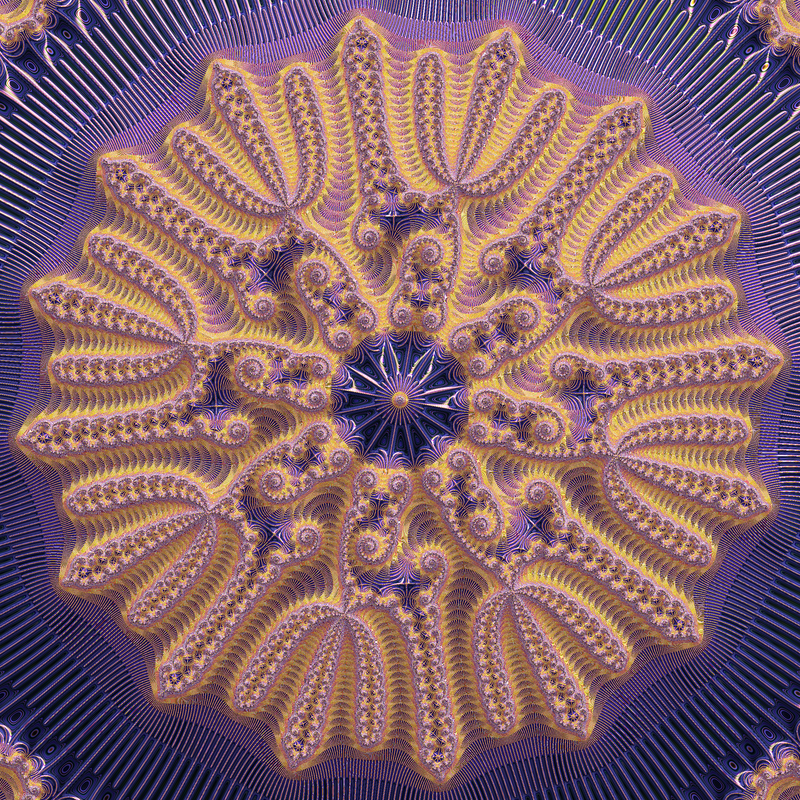Note
Go to the end to download the full example code
09 - A deeper DEM example
This example shows how to create a color layer which displays a distance estimation from the Mandelbrot (power 2) fractal.
The location, at 1.8e-157, is well below the separation power of double, pertubation theory must be used. This location, “Dinkidau flake”, is a common test for numerical reliability.
Reference:
fractalshades.models.Perturbation_mandelbrot

import os
import numpy as np
import fractalshades as fs
import fractalshades.models as fsm
import fractalshades.settings as settings
import fractalshades.colors as fscolors
import fractalshades.projection
from fractalshades.postproc import (
Postproc_batch,
DEM_pp,
Continuous_iter_pp,
Raw_pp,
DEM_normal_pp,
)
from fractalshades.colors.layers import (
Color_layer,
Bool_layer,
Normal_map_layer,
Virtual_layer,
Blinn_lighting
)
def plot(directory):
"""
Example plot of distance estimation method
"""
settings.enable_multithreading = True
# A simple showcase using perturbation technique
precision = 165
nx = 2400
x = '-1.99996619445037030418434688506350579675531241540724851511761922944801584242342684381376129778868913812287046406560949864353810575744772166485672496092803920095332'
y = '-0.00000000000000000000000000000000030013824367909383240724973039775924987346831190773335270174257280120474975614823581185647299288414075519224186504978181625478529'
dx = '1.7e-157'
colormap = fscolors.cmap_register["valensole"]
f = fsm.Perturbation_mandelbrot(directory)
f.zoom(precision=precision,
x=x,
y=y,
dx=dx,
nx=nx,
xy_ratio=1.0,
theta_deg=0.,
projection=fs.projection.Cartesian()
)
f.calc_std_div(
calc_name="div",
subset=None,
max_iter=1000000,
M_divergence=1.e3,
epsilon_stationnary=1.e-3,
BLA_eps=1.e-8,
interior_detect=False
)
# Plot the image
pp = Postproc_batch(f, "div")
pp.add_postproc("potential", Continuous_iter_pp())
pp.add_postproc("DEM", DEM_pp())
pp.add_postproc("interior", Raw_pp("stop_reason", func="x != 1."))
pp.add_postproc("DEM_map", DEM_normal_pp(kind="potential"))
plotter = fs.Fractal_plotter(pp, final_render=False, supersampling="2x2")
plotter.add_layer(Bool_layer("interior", output=False))
plotter.add_layer(Normal_map_layer("DEM_map", max_slope=35, output=False))
plotter.add_layer(Virtual_layer("potential", func=None, output=False))
plotter.add_layer(Color_layer(
"DEM",
func="np.log(x)",
colormap=colormap,
probes_z=[0., 5.0],
output=True
))
plotter["DEM"].set_mask(
plotter["interior"],
mask_color=(0., 0., 0.)
)
plotter["DEM_map"].set_mask(plotter["interior"], mask_color=(0., 0., 0.))
# This is where we define the lighting (here 2 light sources)
# and apply the shading
light = Blinn_lighting(0.35, np.array([1., 1., 1.]))
light.add_light_source(
k_diffuse=0.0,
k_specular=600.,
shininess=200.,
polar_angle=75.,
azimuth_angle=5.,
color=np.array([0.9, 0.9, 0.2]))
light.add_light_source(
k_diffuse=1.9,
k_specular=0.,
shininess=400.,
polar_angle=75.,
azimuth_angle=30.,
color=np.array([1., 1., 1.]))
plotter["DEM"].shade(plotter["DEM_map"], light)
plotter.plot()
if __name__ == "__main__":
# Some magic to get the directory for plotting: with a name that matches
# the file or a temporary dir if we are building the documentation
try:
realpath = os.path.realpath(__file__)
plot_dir = os.path.splitext(realpath)[0]
plot(plot_dir)
except NameError:
import tempfile
with tempfile.TemporaryDirectory() as plot_dir:
fs.utils.exec_no_output(plot, plot_dir)
Total running time of the script: ( 0 minutes 51.742 seconds)